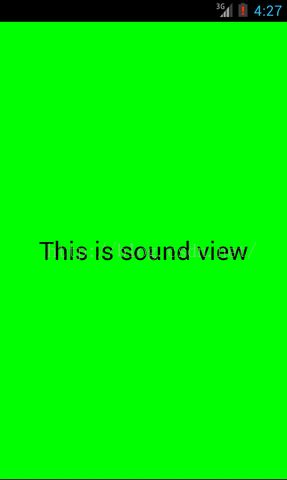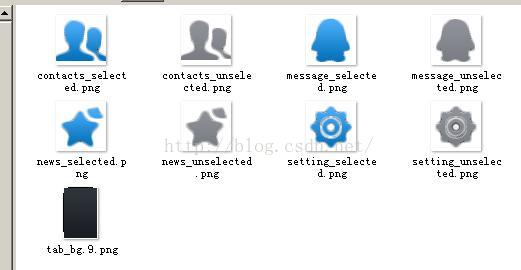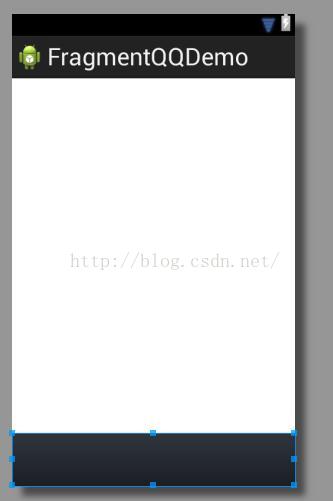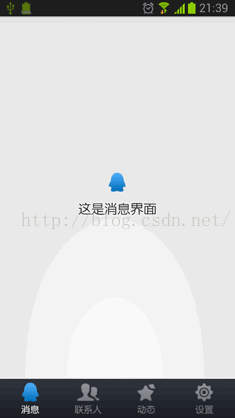Fragment入门以及案例
Android3.0引入了Fragment,语义为碎片,可以让我们更好的利用屏幕空间。
创建
创建一个布局文件,里面的控件就是Fragment中的内容了。
<?xml version="1.0" encoding="utf-8"?> <LinearLayout xmlns:android="http://schemas.android.com/apk/res/android" android:layout_width="match_parent" android:layout_height="match_parent" android:background="#00ff00" > <TextView android:layout_width="wrap_content" android:layout_height="wrap_content" android:text="this is a test" android:textColor="#000000" android:textSize="25sp" /> </LinearLayout>
然后写一个类继承自android.app.Fragment,这里顺便说一些它的生命周期。
import android.annotation.SuppressLint;
import android.app.Activity;
import android.app.Fragment;
import android.os.Bundle;
import android.view.LayoutInflater;
import android.view.View;
import android.view.ViewGroup;
@SuppressLint("NewApi")
public class Fragment1 extends Fragment {
//一旦Fragment被创建,要创建它自己的用户界面时调用
@Override
public View onCreateView(LayoutInflater inflater, ViewGroup container,
Bundle savedInstanceState) {
return inflater.inflate(R.layout.fra1, container, false);
}
//一旦父Activity和Fragment的UI已被创建则调用
@Override
public void onActivityCreated(Bundle savedInstanceState) {
super.onActivityCreated(savedInstanceState);
}
//调用该方法时Fragment会被连接到它的父Activity上
@Override
public void onAttach(Activity activity) {
super.onAttach(activity);
}
//调用该方法来进行Fragment的初始创建
@Override
public void onCreate(Bundle savedInstanceState) {
super.onCreate(savedInstanceState);
}
//在整个生命周期结束时调用
@Override
public void onDestroy() {
super.onDestroy();
}
//当Fragment的View被分离时调用
@Override
public void onDestroyView() {
super.onDestroyView();
}
//当Fragment从它的父Activity上分离时调用
@Override
public void onDetach() {
super.onDetach();
}
//在活动生命周期结束时被调用
@Override
public void onPause() {
super.onPause();
}
//在活动生命周期开始时被调用
@Override
public void onResume() {
super.onResume();
}
//活动生命周期结束时,调用该方法保存UI的状态变化
@Override
public void onSaveInstanceState(Bundle outState) {
super.onSaveInstanceState(outState);
}
//开始时被调用
@Override
public void onStart() {
super.onStart();
}
//在可见生命周期结束时调用
@Override
public void onStop() {
super.onStop();
}
}
在主布局文件中引用
<fragment
android:id="@+id/menu_fragment"
android:name="com.yc.fragmentdemo.MenuFragment"
android:layout_width="fill_parent"
android:layout_height="fill_parent" />
Fragment动态添加
Fragment的真正强大之处在于可以动态添加
动态添加是针对某一块区域进行改变,从而实现对UI的多样化。在这里做个简单的例子。
主布局文件
<LinearLayout xmlns:android="http://schemas.android.com/apk/res/android" android:id="@+id/main_layout" android:orientation="horizontal" android:layout_width="match_parent" android:layout_height="match_parent" android:baselineAligned="false" > </LinearLayout>
还是使用上面的Fragment1类作为实验对象,复制一个Fragment2,仅仅改一下颜色而已。
在主Activity的OnCreate()方法中这样写。如果是竖屏,就使用Fragment1,反之使用Fragment2
@Override
protected void onCreate(Bundle savedInstanceState) {
super.onCreate(savedInstanceState);
setContentView(R.layout.activity_main);
Display display=getWindowManager().getDefaultDisplay(); //获取屏幕的宽度和高度
if(display.getWidth()>display.getHeight()){
Fragment1 fragment1=new Fragment1();
getFragmentManager().beginTransaction().replace(R.id.main_layout, fragment1).commit(); //开启事务加入Fragment并提交
}else{
Fragment2 fragment2=new Fragment2();
getFragmentManager().beginTransaction().replace(R.id.main_layout, fragment2).commit();
}
}
Fragment之间的通信
getActivity() 获取关联的Activity,然后进行findViewById()查找,那么数据就取到了,详细自行百度。
实例 I
安卓屏幕适配问题,如果是平板,那么在UI设计的时候需要俩套方案或者其他屏幕需要更多。暂且只有平板和普通的俩种情况。
如果是普通手机,那么res/layout/activity_main可以满足,如果是平板,那么res/layout-large/activity_main就可以搞定。由安卓系统自行决定运行哪套视图文件。
小技巧:如果俩套方案有不同的ID,那么通过findViewById()可以知道是平板还是普通手机,从而实现不同视图呈现。
res/layout/activity_main
<?xml version="1.0" encoding="utf-8"?> <LinearLayout xmlns:android="http://schemas.android.com/apk/res/android" android:layout_width="fill_parent" android:layout_height="fill_parent" android:orientation="horizontal" > <fragment android:id="@+id/menu_fragment" android:name="com.yc.fragmentdemo.MenuFragment" android:layout_width="fill_parent" android:layout_height="fill_parent" /> </LinearLayout>
res/layout-large/activity_main
<?xml version="1.0" encoding="utf-8"?> <LinearLayout xmlns:android="http://schemas.android.com/apk/res/android" xmlns:tools="http://schemas.android.com/tools" android:layout_width="fill_parent" android:layout_height="fill_parent" android:orientation="horizontal" android:baselineAligned="false" tools:context=".MainActivity" > <fragment android:id="@+id/left_fragment" android:name="com.yc.fragmentdemo.MenuFragment" android:layout_width="0dip" android:layout_height="fill_parent" android:layout_weight="1"/> <FrameLayout android:id="@+id/details_layout" android:layout_width="0dip" android:layout_height="fill_parent" android:layout_weight="3" /> </LinearLayout>
而MenuFragment里面是一个ListView
import android.annotation.SuppressLint;
import android.app.Activity;
import android.app.Fragment;
import android.content.Intent;
import android.os.Bundle;
import android.util.Log;
import android.view.LayoutInflater;
import android.view.View;
import android.view.ViewGroup;
import android.widget.AdapterView;
import android.widget.ArrayAdapter;
import android.widget.ListView;
import android.widget.AdapterView.OnItemClickListener;
@SuppressLint("NewApi")
public class MenuFragment extends Fragment implements OnItemClickListener {
private ListView menuList;
private ArrayAdapter<String> adapter; // 适配器
private String[] menuItems = { "sound", "Display" };
private boolean isTwoPane; // 是否是双页模式
// 当Activity和Fragment关联的时候,初始化适配器数据
@Override
public void onAttach(Activity activity) {
super.onAttach(activity);
adapter = new ArrayAdapter<String>(activity,
android.R.layout.simple_list_item_1, menuItems);
Log.i("fragment", "attach");
}
//加载menu_fragment文件,为ListViwe绑定了适配器,并设置监听事件
@Override
public View onCreateView(LayoutInflater inflater, ViewGroup container,
Bundle savedInstanceState) {
View view = inflater.inflate(R.layout.menu_fragment, container,false);
menuList=(ListView) view.findViewById(R.id.menu_list);
menuList.setAdapter(adapter);
menuList.setOnItemClickListener(this);
Log.i("fragment", "onCreateView");
return view;
}
/*当Activity创建完毕后,尝试获取一下布局文件中是否有details_layout这个元素,
* 如果有说明当前是双页模式,反之则是单页
*/
@Override
public void onActivityCreated(Bundle savedInstanceState) {
super.onActivityCreated(savedInstanceState);
if((getActivity().findViewById(R.id.details_layout))!=null){
isTwoPane=true;
}else{
isTwoPane=false;
}
Log.i("fragment", "onActivityCreated");
}
/**
* 处理ListViw点击事件,会根据当前是否是双页模式进行判断
* 如果是会动态添加Fragment,如果不是会打开新的Activity
*/
@Override
public void onItemClick(AdapterView<?> arg0, View view, int index, long arg3) {
if(isTwoPane){
Fragment fragment=null;
if(index == 0){ //点击第一个
fragment=new SoundFragment();
}else if(index==1){ //点击第二个
fragment=new DisplayFragment();
}
getFragmentManager().beginTransaction().replace(R.id.details_layout, fragment).commit();
}else{
Intent intent=null;
if(index==0){
intent=new Intent(getActivity(),SoundActivity.class);
Log.i("fragment", "OnItemClick.intent");
}else{
intent=new Intent(getActivity(),DisplayActivity.class);
}
startActivity(intent);
}
}
}


实例 II
仿照QQ的底部
素材准备

根据权重划分为俩大区域,系统会自动根据屏幕匹配,即使在平板上也有很好的效果。
<LinearLayout xmlns:android="http://schemas.android.com/apk/res/android" android:layout_width="match_parent" android:layout_height="match_parent" android:orientation="vertical" > <FrameLayout android:id="@+id/content" android:layout_width="match_parent" android:layout_height="0dp" android:layout_weight="1" > </FrameLayout> <LinearLayout android:layout_width="match_parent" android:layout_height="60dp" android:background="@drawable/tab_bg" > </LinearLayout> </LinearLayout>
然后在下面的线型布局中添加四个有背景图片,有文字,内容垂直居中
<RelativeLayout
android:id="@+id/message_layout"
android:layout_width="0dp"
android:layout_height="match_parent"
android:layout_weight="1" >
<LinearLayout
android:layout_width="match_parent"
android:layout_height="wrap_content"
android:layout_centerVertical="true"
android:orientation="vertical" >
<ImageView
android:id="@+id/message_image"
android:layout_width="wrap_content"
android:layout_height="wrap_content"
android:layout_gravity="center_horizontal"
android:src="@drawable/message_unselected" />
<TextView
android:id="@+id/message_text"
android:layout_width="wrap_content"
android:layout_height="wrap_content"
android:layout_gravity="center_horizontal"
android:text="@string/message"
android:textColor="#82858b" />
</LinearLayout>
</RelativeLayout>
<RelativeLayout
android:id="@+id/contacts_layout"
android:layout_width="0dp"
android:layout_height="match_parent"
android:layout_weight="1" >
<LinearLayout
android:layout_width="match_parent"
android:layout_height="wrap_content"
android:layout_centerVertical="true"
android:orientation="vertical" >
<ImageView
android:id="@+id/contacts_image"
android:layout_width="wrap_content"
android:layout_height="wrap_content"
android:layout_gravity="center_horizontal"
android:src="@drawable/contacts_unselected" />
<TextView
android:id="@+id/contacts_text"
android:layout_width="wrap_content"
android:layout_height="wrap_content"
android:layout_gravity="center_horizontal"
android:text="@string/contact"
android:textColor="#82858b" />
</LinearLayout>
</RelativeLayout>
<RelativeLayout
android:id="@+id/news_layout"
android:layout_width="0dp"
android:layout_height="match_parent"
android:layout_weight="1" >
<LinearLayout
android:layout_width="match_parent"
android:layout_height="wrap_content"
android:layout_centerVertical="true"
android:orientation="vertical" >
<ImageView
android:id="@+id/news_image"
android:layout_width="wrap_content"
android:layout_height="wrap_content"
android:layout_gravity="center_horizontal"
android:src="@drawable/news_unselected" />
<TextView
android:id="@+id/news_text"
android:layout_width="wrap_content"
android:layout_height="wrap_content"
android:layout_gravity="center_horizontal"
android:text="@string/news"
android:textColor="#82858b" />
</LinearLayout>
</RelativeLayout>
<RelativeLayout
android:id="@+id/setting_layout"
android:layout_width="0dp"
android:layout_height="match_parent"
android:layout_weight="1" >
<LinearLayout
android:layout_width="match_parent"
android:layout_height="wrap_content"
android:layout_centerVertical="true"
android:orientation="vertical" >
<ImageView
android:id="@+id/setting_image"
android:layout_width="wrap_content"
android:layout_height="wrap_content"
android:layout_gravity="center_horizontal"
android:src="@drawable/setting_unselected" />
<TextView
android:id="@+id/setting_text"
android:layout_width="wrap_content"
android:layout_height="wrap_content"
android:layout_gravity="center_horizontal"
android:text="@string/setting"
android:textColor="#82858b" />
</LinearLayout>
</RelativeLayout>
完成了UI设计,再写业务,根据点击事件来确定显示哪个Fragment
import com.yc.fragment.ContactsFragment;
import com.yc.fragment.MessageFragment;
import com.yc.fragment.NewsFragment;
import com.yc.fragment.SettingFragment;
import android.os.Bundle;
import android.view.View;
import android.view.View.OnClickListener;
import android.view.Window;
import android.widget.ImageView;
import android.widget.TextView;
import android.annotation.SuppressLint;
import android.app.Activity;
import android.app.FragmentManager;
import android.app.FragmentTransaction;
import android.graphics.Color;
@SuppressLint("NewApi")
public class MainActivity extends Activity implements OnClickListener {
private MessageFragment messageFragment;
private ContactsFragment contactsFragment;
private NewsFragment newsFragment;
private SettingFragment settingFragment;
private View messageLayout;
private View contactsLayout;
private View newsLayout;
private View settingLayout;
private ImageView messageImage;
private ImageView contactsImage;
private ImageView newsImage;
private ImageView settingImage;
private TextView messageText;
private TextView contactsText;
private TextView newsText;
private TextView settingText;
private FragmentManager fragmentManager;
@Override
protected void onCreate(Bundle savedInstanceState) {
super.onCreate(savedInstanceState);
requestWindowFeature(Window.FEATURE_NO_TITLE);
setContentView(R.layout.activity_main);
initViews();
fragmentManager = getFragmentManager();
setTabSelection(0);
}
/**
* 初始化界面
*/
private void initViews() {
messageLayout = findViewById(R.id.message_layout);
contactsLayout = findViewById(R.id.contacts_layout);
newsLayout = findViewById(R.id.news_layout);
settingLayout = findViewById(R.id.setting_layout);
messageImage = (ImageView) findViewById(R.id.message_image);
contactsImage = (ImageView) findViewById(R.id.contacts_image);
newsImage = (ImageView) findViewById(R.id.news_image);
settingImage = (ImageView) findViewById(R.id.setting_image);
messageText = (TextView) findViewById(R.id.message_text);
contactsText = (TextView) findViewById(R.id.contacts_text);
newsText = (TextView) findViewById(R.id.news_text);
settingText = (TextView) findViewById(R.id.setting_text);
messageLayout.setOnClickListener(this);
contactsLayout.setOnClickListener(this);
newsLayout.setOnClickListener(this);
settingLayout.setOnClickListener(this);
}
@Override
public void onClick(View view) {
switch (view.getId()) {
case R.id.message_layout:
setTabSelection(0);
break;
case R.id.contacts_layout:
setTabSelection(1);
break;
case R.id.news_layout:
setTabSelection(2);
break;
case R.id.setting_layout:
setTabSelection(3);
break;
}
}
private void setTabSelection(int index) {
clearSelection(); // 清除上次选择的状态
FragmentTransaction transaction = fragmentManager.beginTransaction();
hideFragments(transaction); // 隐藏所有Fragment,防止多个Fragment出现的情况
switch (index) {
case 0:
messageImage.setImageResource(R.drawable.message_selected);
messageText.setTextColor(Color.WHITE);
if(messageFragment==null){
messageFragment=new MessageFragment();
transaction.add(R.id.content , messageFragment );
}else{
transaction.show(messageFragment);
}
break;
case 1:
contactsImage.setImageResource(R.drawable.contacts_selected);
contactsText.setTextColor(Color.WHITE);
if(contactsFragment==null){
contactsFragment=new ContactsFragment();
transaction.add(R.id.content , contactsFragment );
}else{
transaction.show(contactsFragment);
}
break;
case 2:
newsImage.setImageResource(R.drawable.news_selected);
newsText.setTextColor(Color.WHITE);
if(newsFragment==null){
newsFragment=new NewsFragment();
transaction.add(R.id.content , newsFragment );
}else{
transaction.show(newsFragment);
}
break;
case 3:
default:
settingImage.setImageResource(R.drawable.setting_selected);
settingText.setTextColor(Color.WHITE);
if(settingFragment==null){
settingFragment=new SettingFragment();
transaction.add(R.id.content , settingFragment );
}else{
transaction.show(settingFragment);
}
break;
}
transaction.commit(); //一定要提交
}
private void hideFragments(FragmentTransaction transaction) {
if(messageFragment!=null){
transaction.hide(messageFragment);
}
if(contactsFragment!=null){
transaction.hide(contactsFragment);
}
if(newsFragment!=null){
transaction.hide(newsFragment);
}
if(settingFragment!=null){
transaction.hide(settingFragment);
}
}
private void clearSelection() {
messageImage.setImageResource(R.drawable.message_unselected);
messageText.setTextColor(Color.parseColor("#82858b"));
contactsImage.setImageResource(R.drawable.contacts_unselected);
contactsText.setTextColor(Color.parseColor("#82858b"));
newsImage.setImageResource(R.drawable.news_unselected);
newsText.setTextColor(Color.parseColor("#82858b"));
settingImage.setImageResource(R.drawable.setting_unselected);
settingText.setTextColor(Color.parseColor("#82858b"));
}
}
效果图
这只是我的一个粗略总结,以后拿来用的,如果想要深入学习安卓,那么去找郭神吧! 下面有他博客的地址。真的很牛!!!
参照郭神文章 :
http://blog.csdn.net/guolin_blog/article/details/8881711
http://blog.csdn.net/guolin_blog/article/details/8744943
http://blog.csdn.net/guolin_blog/article/details/13171191
我是菜鸟,我在路上。


